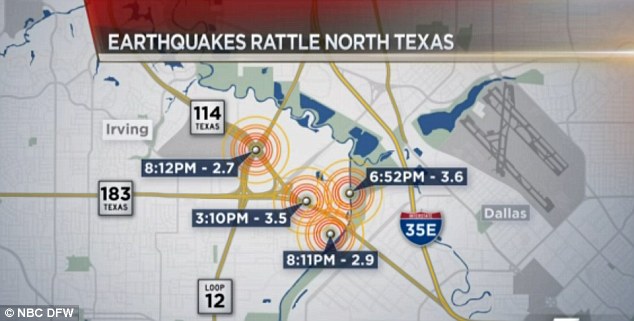
The magnitudes of the earthquakes, which began around 7.30am, ranged from 1.6 to 3.6, according to the USGS. Earthquakes of magnitude 2.5 to 3.0 are generally the smallest people can feel.
The U.S. Geological Service plotted the epicenters of the first four quakes to northeast Irving, a Dallas suburb. At least two of those could be felt throughout the Dallas-Fort Worth area.
Seismologists also installed a new earthquake-monitoring device in Irving this week, after minor temblors rocked an area which is near the site of the former Dallas Cowboys football stadium.
The first quake at 3:10 p.m. measured 3.5 in magnitude. Another at about 7 p.m. measured 3.6, while tremors at 8:11 p.m. and 8:12 p.m. measured less than 3.0.
The first four happened within an area near the Trinity River that's seen a swarm of mild temblors in recent months.
USGS geophysicist Jana Pursley says Tuesday's quakes were the 'largest since the earthquakes started happening there in the last year.'
According to NBC DFW, a 1.7 earthquake took place close to a Dallas intersection at 9:54pm, and a 2.4 earthquake hit Irving's University of Dallas campus at 10:05pm.
A 1.6 earthquake struck at 11:02pm - and like many of the other quakes, was also in the vicinity of the Trinity River, the affiliate station reported.
Carrieann Bedwell, a geophysicist with the USGS in Golden, Colorado, said senior scientists would be investigating the temblors.
'They will be looking at the parameters, magnitude, depth, location of each of the events,' Bedwell said Wednesday. 'Right now we're calling it a swarm, because we've had multitude events happen.'
The seismic series has left residents on edge, wondering if the situation will get worse and what has been behind an uptick in quakes over the last several years.
'The safety and security of our residents is paramount for the city of Irving,' said Irving City Manager Chris Hillman.
Some residents believe the implosion of Texas Stadium in 2010 may have exacerbated problems. There is also speculation the quakes might be related to hydraulic fracturing, or 'fracking,' an energy extraction technique that has a long history in north Texas.
Irving, headquarters of Exxon Mobil's XTO unit that helped pioneer hydraulic fracturing in the region, has two gas wells that were fracked in 2010, according to city officials.
The Irving area, with a population topping 250,000, has had more than 25 minor earthquakes since early September, according to Brian Stump, a seismologist with Southern Methodist University.
'SMU's seismology team is committed to helping North Texans understand more about the increasing number of earthquakes felt in our region over the last few years, most recently near the city of Irving,' Stump said in a statement Tuesday.
SMU researchers installed a seismometer in Irving on Monday. Other devices were set up earlier near Dallas-Fort Worth International Airport and on the Dallas campus.
The study is aimed at pinpointing the quakes' epicenters, Stump said.
About 40 miles west of Irving, a series of small earthquakes rattled the town of Azle a year ago, causing sinkholes and cracks in house foundations. Residents blamed fracking and injection disposal wells for drilling waste as the cause but an official finding is still pending.
Energy industry officials have said fracking is safe and causes no significant seismic damage.



Comment: These earthquake swarms are intensifying! As well as the increasing evidence linking fracking to increased seismic activity, the Earth is 'opening up' as seismologists confirm a global surge of great earthquakes from 2004-2014 and the earthquake frequency increasing rate of strong quakes doubles in 2014
To understand why this is happening, read Earth Changes and the Human-Cosmic Connection. Here's a relevant excerpt: